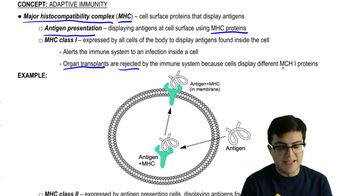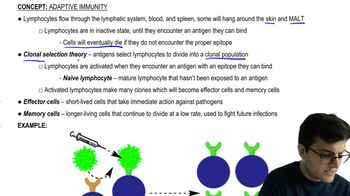Table of contents
- 1. Introduction to Biology2h 42m
- 2. Chemistry3h 40m
- 3. Water1h 26m
- 4. Biomolecules2h 23m
- 5. Cell Components2h 26m
- 6. The Membrane2h 31m
- 7. Energy and Metabolism2h 0m
- 8. Respiration2h 40m
- 9. Photosynthesis2h 49m
- 10. Cell Signaling59m
- 11. Cell Division2h 47m
- 12. Meiosis2h 0m
- 13. Mendelian Genetics4h 44m
- Introduction to Mendel's Experiments7m
- Genotype vs. Phenotype17m
- Punnett Squares13m
- Mendel's Experiments26m
- Mendel's Laws18m
- Monohybrid Crosses19m
- Test Crosses14m
- Dihybrid Crosses20m
- Punnett Square Probability26m
- Incomplete Dominance vs. Codominance20m
- Epistasis7m
- Non-Mendelian Genetics12m
- Pedigrees6m
- Autosomal Inheritance21m
- Sex-Linked Inheritance43m
- X-Inactivation9m
- 14. DNA Synthesis2h 27m
- 15. Gene Expression3h 20m
- 16. Regulation of Expression3h 31m
- Introduction to Regulation of Gene Expression13m
- Prokaryotic Gene Regulation via Operons27m
- The Lac Operon21m
- Glucose's Impact on Lac Operon25m
- The Trp Operon20m
- Review of the Lac Operon & Trp Operon11m
- Introduction to Eukaryotic Gene Regulation9m
- Eukaryotic Chromatin Modifications16m
- Eukaryotic Transcriptional Control22m
- Eukaryotic Post-Transcriptional Regulation28m
- Eukaryotic Post-Translational Regulation13m
- 17. Viruses37m
- 18. Biotechnology2h 58m
- 19. Genomics17m
- 20. Development1h 5m
- 21. Evolution3h 1m
- 22. Evolution of Populations3h 52m
- 23. Speciation1h 37m
- 24. History of Life on Earth2h 6m
- 25. Phylogeny2h 31m
- 26. Prokaryotes4h 59m
- 27. Protists1h 12m
- 28. Plants1h 22m
- 29. Fungi36m
- 30. Overview of Animals34m
- 31. Invertebrates1h 2m
- 32. Vertebrates50m
- 33. Plant Anatomy1h 3m
- 34. Vascular Plant Transport1h 2m
- 35. Soil37m
- 36. Plant Reproduction47m
- 37. Plant Sensation and Response1h 9m
- 38. Animal Form and Function1h 19m
- 39. Digestive System1h 10m
- 40. Circulatory System1h 57m
- 41. Immune System1h 12m
- 42. Osmoregulation and Excretion50m
- 43. Endocrine System1h 4m
- 44. Animal Reproduction1h 2m
- 45. Nervous System1h 55m
- 46. Sensory Systems46m
- 47. Muscle Systems23m
- 48. Ecology3h 11m
- Introduction to Ecology20m
- Biogeography14m
- Earth's Climate Patterns50m
- Introduction to Terrestrial Biomes10m
- Terrestrial Biomes: Near Equator13m
- Terrestrial Biomes: Temperate Regions10m
- Terrestrial Biomes: Northern Regions15m
- Introduction to Aquatic Biomes27m
- Freshwater Aquatic Biomes14m
- Marine Aquatic Biomes13m
- 49. Animal Behavior28m
- 50. Population Ecology3h 41m
- Introduction to Population Ecology28m
- Population Sampling Methods23m
- Life History12m
- Population Demography17m
- Factors Limiting Population Growth14m
- Introduction to Population Growth Models22m
- Linear Population Growth6m
- Exponential Population Growth29m
- Logistic Population Growth32m
- r/K Selection10m
- The Human Population22m
- 51. Community Ecology2h 46m
- Introduction to Community Ecology2m
- Introduction to Community Interactions9m
- Community Interactions: Competition (-/-)38m
- Community Interactions: Exploitation (+/-)23m
- Community Interactions: Mutualism (+/+) & Commensalism (+/0)9m
- Community Structure35m
- Community Dynamics26m
- Geographic Impact on Communities21m
- 52. Ecosystems2h 36m
- 53. Conservation Biology24m
41. Immune System
Adaptive Immunity
Problem 4`
Textbook Question
Which of the following statements is not true?
a. An antibody has more than one antigen-binding site.
b. A lymphocyte has receptors for multiple different antigens.
c. An antigen can have different epitopes.
d. A liver or muscle cell makes one class of MHC molecule.
 Verified step by step guidance
Verified step by step guidance1
Understand the role of antibodies: Antibodies are proteins produced by the immune system to identify and neutralize foreign objects like bacteria and viruses. Each antibody has multiple antigen-binding sites, typically two, allowing it to bind to antigens.
Examine lymphocyte receptors: Lymphocytes, such as B cells and T cells, have receptors on their surfaces. Each lymphocyte is specific to a single antigen, meaning it has receptors for only one type of antigen, not multiple different antigens.
Explore antigen structure: Antigens are substances that can induce an immune response. They can have multiple epitopes, which are specific parts of the antigen that antibodies or receptors bind to.
Review MHC molecules: Major Histocompatibility Complex (MHC) molecules are proteins found on the surface of cells that present antigen fragments to T cells. Different cells express different classes of MHC molecules. For example, liver or muscle cells typically express MHC class I molecules.
Identify the incorrect statement: Based on the understanding of antibodies, lymphocytes, antigens, and MHC molecules, determine which statement does not align with biological principles. Focus on the statement about lymphocyte receptors, as it contradicts the specificity of lymphocytes to a single antigen.
 Verified video answer for a similar problem:
Verified video answer for a similar problem:This video solution was recommended by our tutors as helpful for the problem above
Video duration:
5mPlay a video:
Was this helpful?
Key Concepts
Here are the essential concepts you must grasp in order to answer the question correctly.
Antibody Structure
Antibodies are Y-shaped proteins produced by B cells that have multiple antigen-binding sites, typically two, allowing them to bind to specific antigens. These binding sites are located at the tips of the 'Y' and are highly variable, enabling the immune system to recognize a vast array of antigens.
Recommended video:
Guided course

Community Structure
Lymphocyte Receptors
Lymphocytes, such as B cells and T cells, have receptors that are specific to one type of antigen. Each lymphocyte is equipped with receptors that recognize a unique antigen, ensuring a targeted immune response. This specificity is crucial for the adaptive immune system's ability to remember and respond to pathogens.
Recommended video:
Guided course

Intracellular Receptors
Major Histocompatibility Complex (MHC)
MHC molecules are proteins found on the surface of cells that present antigen fragments to T cells. There are two main classes: MHC class I, present on almost all nucleated cells, and MHC class II, found on specialized antigen-presenting cells. Liver and muscle cells typically express MHC class I molecules, which are essential for presenting intracellular antigens to cytotoxic T cells.
Recommended video:
Guided course

Major Histocompatibility Complex

 5:50m
5:50mWatch next
Master Adaptive Immune Response with a bite sized video explanation from Jason
Start learningRelated Videos
Related Practice



























































